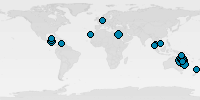
Julian Rocks is one of the best reserves in New South Wales with spectacular dive sites and numerous marine creatures.
| Inserted/Added by: | lars, © Author: Lars Hemel |
| Rated: | Rated 2.3, 12 votes |
Send us your images for this dive region[Add Image][Add Movie]
Julian Rocks, named by Captain James Cook in 1776, is known as one of the best marine reserves in New South Wales. Julian Rocks Marine Reserve became part of Cape Byron Marine Park in 2002 and the waters surrounding this rocky outcrop have been designated as a Sanctuary Zone for most of the year. These small sedimentary rocks were formed during a volcanic eruption long ago, creating many different dive sites, all rich in aquatic life and coral species. According to Bundjalung legend, the rocks are formed out of the back and front parts of a canoe when it broke in two and sank to the bottom. It was a jealous husband that threw its spear at its wife and lover, romantic sitting in a canoe, causing the canoe to sink.
Popular are the many humpback whales that migrate through this area from May to October. Other common species are dolphins, often playfully seen next to the boat during the three minute boat trip from Byron Bay's Main Beach to Julian Rocks. As an extra, you get a chance to see seabirds such as seagulls and cormorants. Moorings are placed around the rocks to prevent damage coming from wild anchorage and local government has set a limit on the number of boats that can dive there.
Because of the warm tropical currents from the north and the cooler nutrient rich ocean currents from the south, you can find tropical barrier reef fish as well as pelagic species more common in cold waters. There are three different species of sea turtles found year-round, grey nurse sharks in winter, manta rays gracefully flowing in search of plankton in the warmer summer months and schools of brightly colored blue tang in spring. Although coral growth is limited, sponges, sea stars, hard corals and soft corals are decorating the rocks. Coral reef fish in all sizes and colors are seen while diving at one of the many spectacular dive sites around Julian Rocks.
[Add Message]Messages from readers:
[Add Divelog]Divelogs from members:
